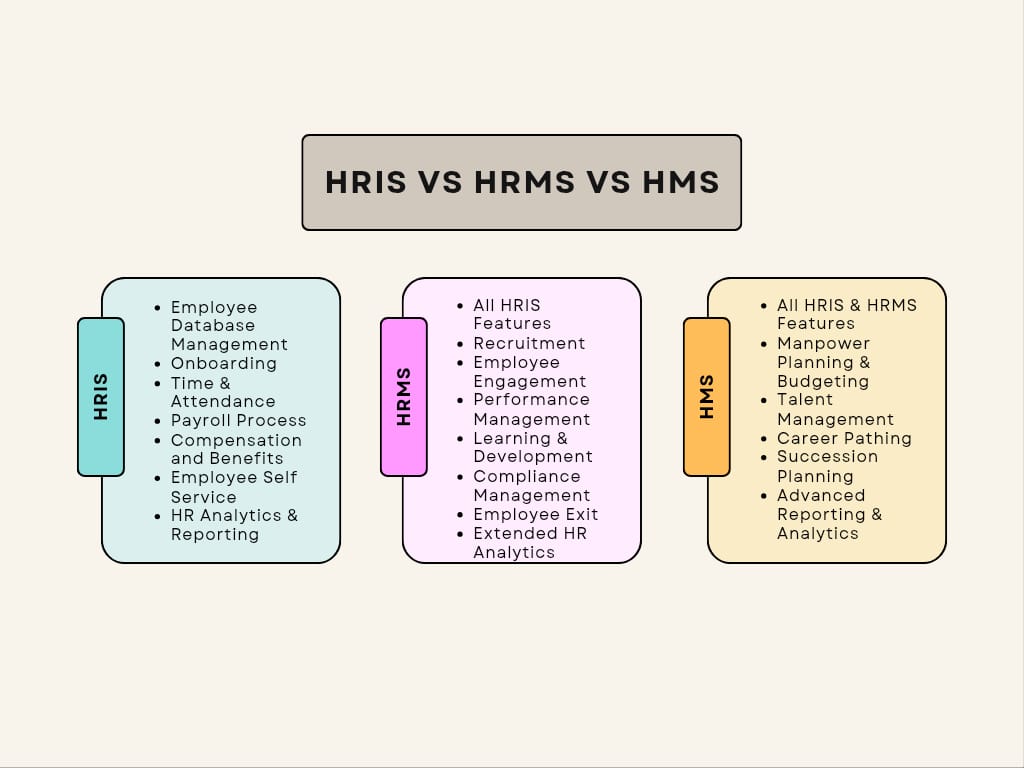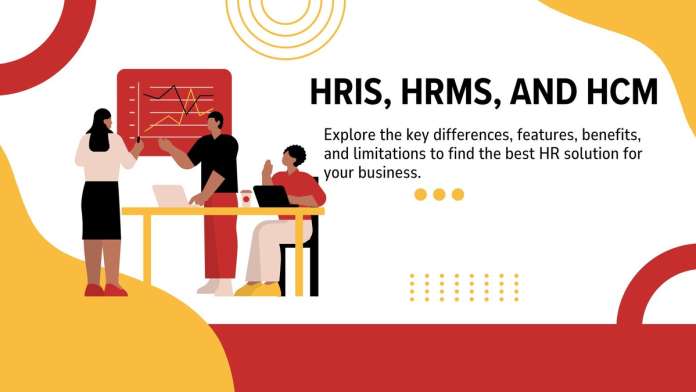In the era of digital transformation, businesses are thriving on the augment of technology. The induction of business software has changed the landscape of business operations around the globe. As an integral part of the system, software applications and tools are aiding business processes by analyzing organizational needs and delivering software solutions in the areas of Customer Relationships, Communication, Project Management, Marketing, Accounting, Human Resources (HRIS, HRMS and HCM) among many others.
Software tools for businesses are effectively employed to automate processes, which can significantly reduce manual documentation, rectify errors, monitor critical data, facilitate decision-making, and improve business efficiency.
What is the Human Resource Management System (HR Software)?
HR software is designed to offer a host of tools instrumental in managing the most important asset of an organization—human resources. It enables HR Teams to seamlessly manage different functions and work processes related to the Personnel Department, such as administration of personnel records, employee onboarding, time and leave management, payroll management, performance management, and many other activities related to employee life cycle management.
The market is emerging with innovative HR software solutions developed to support the ever evolving business practices. Trying to pick an ideally fit software for your company may be a heavy duty task at hand. More so, when the features of certain software solutions like HRIS, HRMS, & HCM are too closely related to differentiate. Through this article, we will evaluate each aspect of these applications and comprehend their technical differences and applicability.

What is HRIS?
Human Resource Information System, or HRIS, is a software system that assists organizations in collecting, storing, and managing employee data, enabling accurate record keeping and improving access to employee related information.
The humble beginnings of HRIS dates back to the 1950s & 1960s, which eventually gained traction during the 1980s with the growing popularity of Enterprise Resource Planning (ERP) and shifting focus from mainstream computing to client-server technology. As of date, we may find most firms prefer cloud-based systems over on-premise installation.
What does it offer?
A comprehensive HRIS is a central storehouse of employee database. Furthermore, it also automates HR work processes, including,
- Employee Demographics
- Employment History
- Employee Onboarding
- Time Office Management
- Payroll Process
- Compensation & Benefits
- Employee Self Service
- HR Analytics and Reporting
How does it benefit?
HRIS, as we now know, is one of the simplest HR software to work with. It helps HR professionals with:
- Access to a centralized database of employees with essential information to facilitate decision-making.
- Automation of routine work processes alleviating the need for cumbersome paperwork.
- Reducing administrative time and resources by digitizing core HR functions.
- Foundational support to HRIS & HRMS from automated and centralized record keeping.
What are its limitations?
A robust HRIS may also come with challenges such as,
- High cost of implementation & maintenance.
- Lengthy and inflexible transition from manual processes to automation.
- Limited user experience as many HRIS platform do not incorporate advanced HR functionalities.
What is HRMS?
HRMS stands for Human Resource Management System. It is an extension of HRIS software application that enables businesses to manage the basic to most sophisticated life cycle of their workforce. Through the integration of HRMS with the built in features of HRIS, HR Professionals can effortlessly handle intricate HR functions and navigate beyond transactional data . An efficient HRMS application is built with the capability of advanced workflow automation providing real time insights in HR trends improving HR management at workplace.
HRMS emerged prominently during the 1990’s with the growth of cloud technology. Notably, PeopleSoft became the first company to adopt a fully integrated client server HRMS application which paved way for significant milestones in the development of HR software and related applications over the period of time.
What does it offer?
A complete suite of HRMS assists firms with a range of HR functions such as
- Employee Data Management
- Recruitment & Onboarding
- Time & Attendance
- Payroll & Benefits Administration
- Compliance Management
- Employee Self Service & PTO
- Employee Engagement
- Performance Management
- Learning & Development
- Employee Exit
- HR Analytics
What are its benefits ?
HRMS greatly benefits companies while dealing with their workforce in terms of
- Streamlined recruitment process with the integration of Applicant Tracking System (ATS).
- Improved productivity and performance of employees by monitoring KPI’s.
- Better decision making facilitated by centralized information across all HR functions.
- Improved employee engagement and business output as a result of simplified HR practices.
What are its limitations ?
Implementation of HRMS may result in efficient process management, still, the system suffers from few downsides such as,
- Non customization of HRMS system with existing HR policies and processes.
- Resistance to change to an upgraded system of work.
- Complexities in migration of data may compromise its authenticity.
- Costly to implement and costlier to maintain.
What is HCM?
HCM or Human Capital Management, is a modern-age HR solution that transcends contemporary HR practice, expanding into a dynamic and strategic tool of management. To address the evolving need of business operations, HCM assists organizations in strengthening its workforce to create more value and drive business success. As smart software, HCM takes care of complete employee life cycle, optimizes processes, and stimulates organizational performance.
HCM software systems evolved during the late 1990’s with the surge in internet and cloud-based solutions that enabled wider accessibility and scalability along with data analytics capabilities to analyze workforce trends, yielding strategic decision-making based on employee data.
What does it offer?
HCM applications broadly encompasses all comprehensive features of HRIS and HRMS software in addition to strategic and analytical tools, among them are
- Employee Database Management
- Manpower Planning & Budgeting
- Talent Management
- Payroll & Compensation
- Succession Planning
- Advanced Reporting & Analytics
What are its benefits ?
Here is how HCM software benefits the HR eco system and entire organization as a whole
- Advanced HR tools allows businesses to adhere to all legal and regulatory policies keeping them on top of compliance.
- Dynamic reporting and analytics on key HR metrics furnishes data on productivity per employee.
- Drives strategic initiatives such as organizational restructuring, talent optimization and pay revision.
- Integration capabilities with other business software tools facilitates smooth data flow and efficient processes.
What are its limitations ?
HCM backed with AI and cloud technology is considered to be the future of HR software solutions. Although versatile in approach, it also has few pitfalls such as
- Complex implementation due to wide range of features requiring significant time and expertise to configure properly.
- Substantial investment at implementation stage and longer gaps in ROI discourages user adoption.
- Non alignment of HR strategy with broader business objectives may defeat the purpose of the application.
- Insufficient training in operating the software may cause dissatisfaction and resistance among team members.
Differences between HRIS, HRMS & HCM: A bird’s eye view.
The growing complexities in HR operations has driven dynamic software solutions resulting into a trail of software application for each HR function. Amidst the pool of HR software’s, understanding the features and scope of each software system is a step towards choosing the one that’s right for your business.
Apparently, there is a thin line between the abbreviated terms HRIS, HRMS and HCM. As branches of one family tree, they are interrelated since they share common features and functions either partially or entirely. All three systems are designed to meticulously manage employee data, automate and streamline core HR functions to improve efficiency.
Regardless of how similar they sound, the key differences lies in their gamut of functions and level of complexity.
Watch this video (created by Intelloger) explaining the difference between HRIS vs HCM.
HRIS VS HRMS VS HCM
HRIS is a fundamental software that covers primary functions of HR management focusing more on employee data collection and supports essential data analytics. It relieves HR personnel by automating basic HR modules such as employee onboarding, time and attendance, payroll processing, and saves quality time for more productive activities.
HRMS is a comprehensive solution addressing more features in addition to the capabilities of HRIS system. Simply put, HRMS harnesses on the database management proficiency of HRIS to offer more advanced HR functions like performance management, training and employee engagement.
HCM, on the other hand, is a cutting edge solution that combines the attributes of HRIS and HRMS together with its unique functions addressing workforce planning, career building and succession planning to promote employee growth and wellness within the organization. Its advanced data analytics and reporting capabilities in real time helps businesses in strategic decision making , improves compliance and boosts productivity.
HRIS, HRMS and HCM Applicability
HRIS plays a crucial role in ensuring the accuracy of employee records and effectively managing key HR processes. It is mostly suitable for small businesses aiming to digitize their HR functions, establishing a firm foundation for the implementation of more sophisticated systems.
HRMS expands upon the functionalities of HRIS by incorporating features such as recruitment, onboarding, and performance management. This makes it particularly advantageous for mid level firms seeking to elevate their HR processes beyond basic administrative functions, prioritizing core HR functions and the development of employees.
HCM represents the most sophisticated levels of human resource systems, which integrates comprehensive HRMS functionalities with strategic planning and development tools for human resources. It is particularly beneficial for large-scale organizations operating nationally or globally that aspire to align their HR initiatives with business objectives, concentrating on optimizing the value derived from their workforce.
Also Read: https://stacksynk.com/blog/how-to-create-a-resume-step-by-step-guide/

[…] Also Read: HRIS vs HRMS vs HCM: Which Is Right HR Software for Your Business […]